Differential phosphorylation and dephosphorylation of beta2-adrenoceptor sites Ser262 and Ser355,356
- PMID: 16331289
- PMCID: PMC1751300
- DOI: 10.1038/sj.bjp.0706551
Differential phosphorylation and dephosphorylation of beta2-adrenoceptor sites Ser262 and Ser355,356
Abstract
Activated beta2-adrenoceptors are rapidly desensitized by phosphorylation of Ser262 by protein kinase A (PKA) and of Ser355,356 by G-protein-coupled receptor kinase (GRK). We sought to determine whether the phosphorylation and subsequent dephosphorylation of these sites had similar kinetics and requirements for receptor endocytosis. The phosphorylation of the PKA and GRK sites were measured using antibodies that recognize phosphoserine 262 and phosphoserine 355,356. Endocytosis in stably transfected HEK293 cells was blocked by inducible expression of dominant-negative dynamin-1 K44A or by treatment with hypertonic sucrose. The phosphorylation of the GRK site Ser355,356 during a 10 microM isoprenaline treatment rapidly reached a steady state, and the extent of kinetics of phosphorylation were unaffected by dynamin-1 K44A expression, and minimally by hypertonic sucrose. In contrast, phosphorylation of the PKA site Ser262 during a 10 microM isoprenaline treatment peaked after 2 min and then rapidly declined, while inhibition of endocytosis enhanced and prolonged phosphorylation. Treatment with 300 pM isoprenaline, a concentration too low to provoke endocytosis, also resulted in prolonged PKA site phosphorylation. The dephosphorylation of these sites was measured after removal of agonist. Significant dephosphorylation of phosphoserines 262 and 355,356 was observed under conditions of very low endocytosis, however dephosphorylation of the GRK site was greater if antagonist was present after removal of agonist. The results indicate that the kinetics of beta2-adrenoceptor GRK and PKA site phosphorylation are distinct and differently affected by endocytosis, and that receptor dephosphorylation can occur either at the plasma membrane or in internal compartments.
Figures
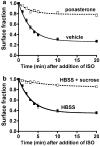
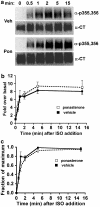
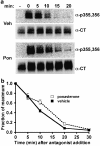
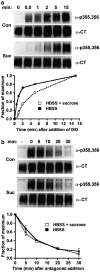

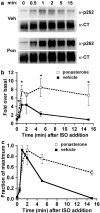
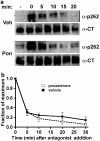
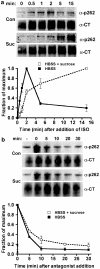
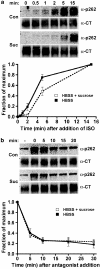
Comment in
-
G-protein-coupled receptor dephosphorylation at the cell surface.Br J Pharmacol. 2006 Feb;147(3):235-6. doi: 10.1038/sj.bjp.0706553. Br J Pharmacol. 2006. PMID: 16331287 Free PMC article. No abstract available.
Similar articles
-
Characterization of agonist stimulation of cAMP-dependent protein kinase and G protein-coupled receptor kinase phosphorylation of the beta2-adrenergic receptor using phosphoserine-specific antibodies.Mol Pharmacol. 2004 Jan;65(1):196-206. doi: 10.1124/mol.65.1.196. Mol Pharmacol. 2004. PMID: 14722251
-
Characterization of beta2-adrenergic receptor dephosphorylation: Comparison with the rate of resensitization.Mol Pharmacol. 2007 Jan;71(1):47-60. doi: 10.1124/mol.106.028456. Epub 2006 Sep 29. Mol Pharmacol. 2007. PMID: 17012621
-
Mutating the dileucine motif of the human beta(2)-adrenoceptor reduces the high initial rate of receptor phosphorylation by GRK without affecting postendocytic sorting.Eur J Pharmacol. 2010 Jun 10;635(1-3):9-15. doi: 10.1016/j.ejphar.2010.02.033. Epub 2010 Mar 1. Eur J Pharmacol. 2010. PMID: 20193676 Free PMC article.
-
Salmeterol stimulation dissociates beta2-adrenergic receptor phosphorylation and internalization.Am J Respir Cell Mol Biol. 2007 Feb;36(2):254-61. doi: 10.1165/rcmb.2006-0158OC. Epub 2006 Sep 15. Am J Respir Cell Mol Biol. 2007. PMID: 16980556 Free PMC article.
-
The beta-adrenergic receptors.Herz. 2002 Nov;27(7):683-90. doi: 10.1007/s00059-002-2434-z. Herz. 2002. PMID: 12439640 Review.
Cited by
-
Regulation of G protein-coupled receptor signaling by plasma membrane organization and endocytosis.Traffic. 2019 Feb;20(2):121-129. doi: 10.1111/tra.12628. Epub 2019 Jan 11. Traffic. 2019. PMID: 30536564 Free PMC article. Review.
-
Cyclic AMP signalling pathways in the regulation of uterine relaxation.BMC Pregnancy Childbirth. 2007 Jun 1;7 Suppl 1(Suppl 1):S10. doi: 10.1186/1471-2393-7-S1-S10. BMC Pregnancy Childbirth. 2007. PMID: 17570154 Free PMC article. Review.
-
The subtleties of µ-opioid receptor phosphorylation.Br J Pharmacol. 2011 Sep;164(2):294-7. doi: 10.1111/j.1476-5381.2011.01387.x. Br J Pharmacol. 2011. PMID: 21449916 Free PMC article.
-
Roles of GRK and PDE4 activities in the regulation of beta2 adrenergic signaling.J Gen Physiol. 2008 Apr;131(4):349-64. doi: 10.1085/jgp.200709881. Epub 2008 Mar 17. J Gen Physiol. 2008. PMID: 18347080 Free PMC article.
-
Stereochemistry of an agonist determines coupling preference of beta2-adrenoceptor to different G proteins in cardiomyocytes.Mol Pharmacol. 2009 Jan;75(1):158-65. doi: 10.1124/mol.108.051078. Epub 2008 Oct 7. Mol Pharmacol. 2009. PMID: 18838481 Free PMC article.
References
-
- BROWN B.M., CARLSON B.L., ZHU X., LOLLEY R.N., CRAFT C.M. Light-driven translocation of the protein phosphatase 2A complex regulates light/dark dephosphorylation of phosducin and rhodopsin. Biochemistry. 2002;41:13526–13538. - PubMed
-
- CONG M., PERRY S.J., LIN F.T., FRASER I.D., HU L.A., CHEN W., PITCHER J.A., SCOTT J.D., LEFKOWITZ R.J. Regulation of membrane targeting of the G protein-coupled receptor kinase 2 by protein kinase A and its anchoring protein AKAP79. J. Biol. Chem. 2001;276:15192–15199. - PubMed
Publication types
MeSH terms
Substances
Grants and funding
LinkOut - more resources
Full Text Sources

